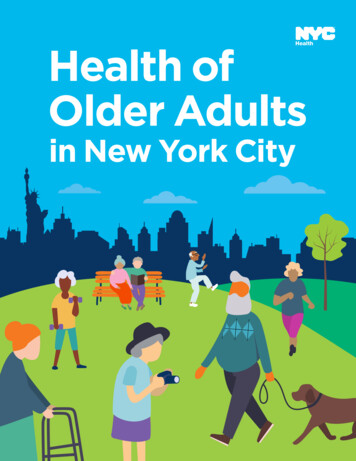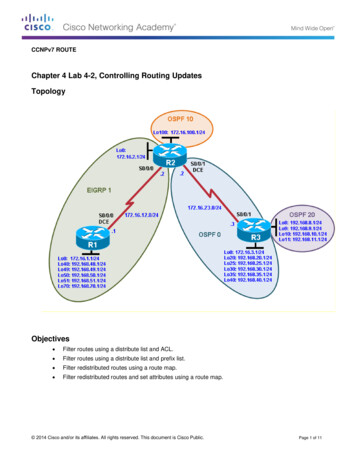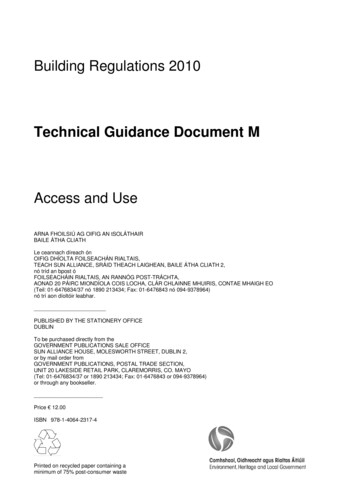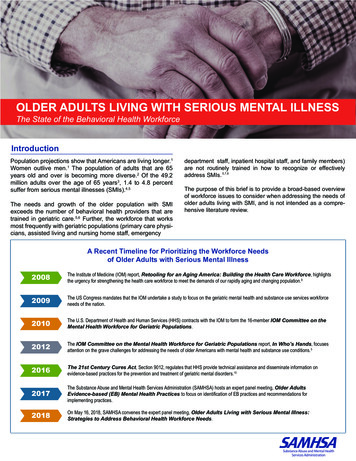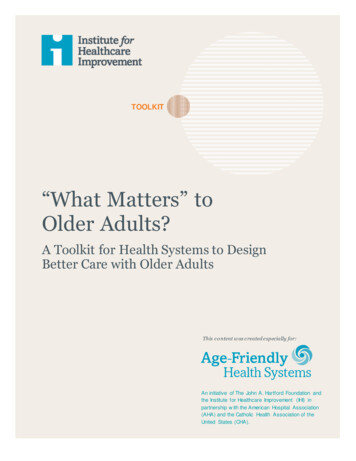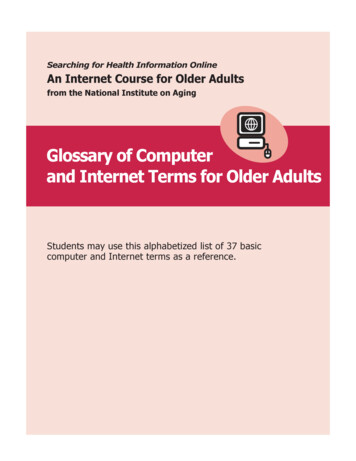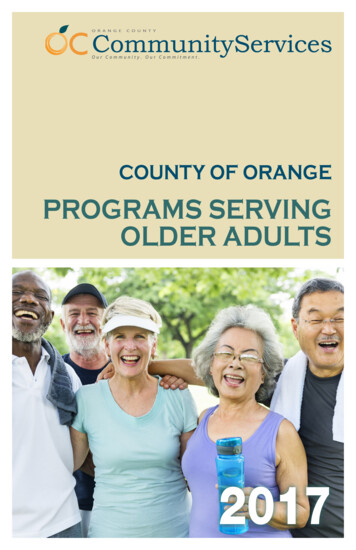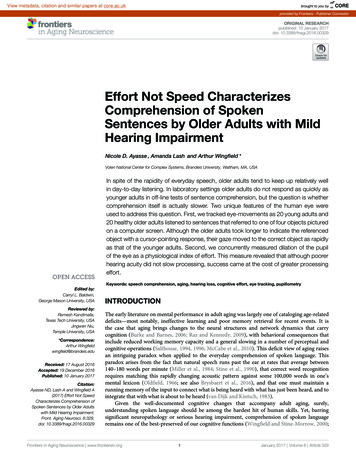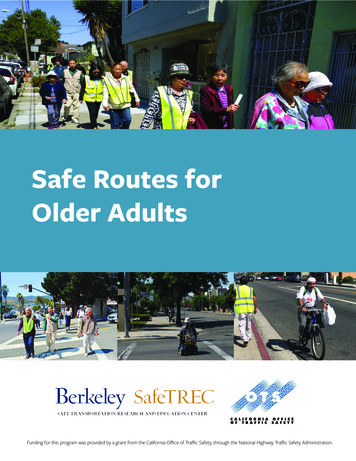
Transcription
Safe Routes forOlder AdultsFunding for this program was provided by a grant from the California Office of Traffic Safety, through the National Highway Traffic Safety Administration.
Report prepared by:UC Berkeley SafeTRECTracy McMillan, PhD, MPH, Senior Policy & Project AnalystAna Lopez, Policy and Project AnalystJill Cooper, MSW, Co-Directorhttps://safetrec.berkeley.edu/April 2018AcknowledgementsThe authors would like to thank Karissa Anderson and Patti Horsley with the California Departmentof Public Health Older Adult Injury Prevention Program for their contributions to the Safe Routes forOlder Adults Guide. We would also like to thank Walk San Francisco and Los Angeles Walks for sharingpictures from their community workshops, and Lisa Peterson and Bor-Wen Tsai with SafeTREC fortheir assistance on the guide’s graphic design and data components. We are grateful to our partnersat Cal Walks, led by Tony Dang and Jaime Fearer, and to our colleagues Katherine Chen, GarrettFortin, Lisa Peterson and Amanda Reynosa on the SafeTREC Community Pedestrian and Bicycle SafetyTraining team, for their leadership in conducting community outreach and training. Lastly, we thankthe California Office of Traffic Safety for their support of the work being done in communities acrossCalifornia to promote safe and active transportation.
SAFE ROUTES FOROLDER ADULTSTABLE OF CONTENTSINTRODUCTION1AGING POPULATION STATISTICS1OLDER ADULT TRANSPORTATION STATISTICS3BULDING A STAKEHOLDER NETWORK5THE 6 E’S6EVALUATION6EQUITY AND COURAGEMENT14MAINTAINING MOMENTUM14SAFE ROUTES FOR OLDER ADULTS RESOURCES15EXAMPLES OF SAFE ROUTES FOR OLDER ADULTS PROJECTS17REFERENCES18
IntroductionWhether rural, suburban or urban dweller, transportation is a critical lifeline to meet the needs ofdaily living, maintain independence and enable social connection.Walking and bicycling are important transportation alternatives to motor vehicle travel. They arealso important sources of physical activity and social connectedness. Creating and/or enhancingenvironments to be more supportive of walking and bicycling has been a significant initiative withinthe transportation and health communities for over a decade, with important progress in manylocations. Rates of walking and bicycling are up in California, and active transportation policies havebecome more institutionalized at the state and local level (e.g., Caltrans’ “Toward An Active CaliforniaState Bicycle/Pedestrian Plan” and the City of Los Angeles Complete Streets Design Guide).With the increased focus on walking and bicycling comes opportunities to improve the safety of thetransportation environment for all users. This guide provides communities with backgroundinformation on walking and bicycling safety for older adults and tools to make transportationin California communities age-friendly for all.Aging Population StatisticsMaking communities age-friendly and transportation systems supportive of all road users is incrediblyimportant as we consider some of the demographic shifts underway. With the aging of the BabyBoomer generation (and Generation X, to a lesser degree), the older adult population will increasesignificantly over the next few decades in California and the United States as a whole: The older adult population in the United States aged 65 and older is expected to almostdouble between 2012 and 2050, from 43.1 million to 83.7 million.The California Department of Aging estimates that by 2050 13.9 Californians will be 60 orolder, representing over 25% of the state population. Over 2.5 million of those individuals willbe 85 or older.This age wave is largely due to the Baby Boomers “coming of age” and increased survivorshiprates.While Californians are living longer, they are facing health concerns. Over 80% of older adultshave at least one chronic condition, and 50% have at least two.The growth in population of older adults in California is expected to occur in all but themost rural counties, with the largest increases in the Central Valley and Southern Californiacounties.The California Department of Finance prepared an interactive population pyramid to demonstratethe growing older adult population (Figure 1).1
Figure 1 Population Projections for the State of California in 2018 and 2050Source: CA Department of Finance2
Older AdultTransportation Statistics15%61%8.5%of all licensed drivers areover 65 (2011)of Californians over 75hold a driver’s license(2015)of all trips made bypersons 60 and older arewalking trips (2004)According to the 2016 California HealthInterview Survey, twenty four percent ofindividuals sixty and over in California live inone-person households. Females sixty andover live in one-person households morefrequently than males (28.7% vs. 19%).Transportation constraints such as unsafeplaces to walk or bicycle or limited transitor auto access, can contribute to socialisolation, which negatively impacts mentaland physical health.While the current pattern of travel indicates that the majority of trips taken by older adults are byautomobile (as driver or passenger), the second most frequent mode of travel is walking. Futureexpectations mirror current patterns. Additionally, it is important to note that every motorized trip(auto or transit) begins and ends on foot.The benefits of walking for older adults are many: increased physical activity, travel independence,and social connection are but a few. However, older adults are disproportionately represented inpedestrian injuries and fatalities both nationally and in California: Nationally, older adult pedestrian fatalities occur at 2-3 times the rate of the generalpopulation. In California, pedestrian fatalities age 65 and older increased 19.8 percent from 202 in 2015to 242 in 2016. More emergency department visits and hospitalizations in 2014 for non-fatal pedestrianrelated injuries were seen among Black Californians 65 and older than other race/ethnicities.Two primary factors behind these high rates of older adult pedestrian injury and fatality are: 1)increased susceptibility of injury and risk of death when collisions occur; and 2) a transportationinfrastructure poorly designed for pedestrians, particularly more vulnerable pedestrians. TheCalifornia Manual of Uniform Traffic Control Devices (CA MUTCD) recommends using a walking speedof 3.5 ft/s ( 1.07m/s) as the standard at most signalized pedestrian crossings. Since the walking speedof many older adults (as well as other road users) is slower than that, the potential for conflict andanxiety between road users is high (Figure 2). Given this, the CA MUTCD was updated in the pastseveral years with the recommendation of a walking speed of 2.8 ft/s ( 0.85 m/s) in locations whereolder or disabled pedestrians routinely use a crosswalk.3
Figure 2 Expected Crossing Distance for Different Road Users: “Can You Make the Light?”Photo Credit: Kristin Agnello, Plassurban.comHospital data (i.e., emergency department and hospitalizations) plays an important role in the trafficsafety system, as a complementary data source to police-reported crash data and fatality data forcomprehensive reporting on traffic collisions. For example, while there were 183 pedestrian fatalitiesin 2014, hospital data shows that in 2014 1,561 pedestrians age 65 and older were treated for injuries inemergency departments (ED) (Figure 3). Since 2006, the rate of older Californians treated in ED forpedestrian and bicycle-related injuries has been growing, with larger increases seen among ED visitsdue to bicycle-related injuries than pedestrian related injuries.Figure 3 Hospital DataSource: California Department of Public Health’s EpiCenter4
Building a Stakeholder NetworkBuilding a stakeholder network is about bringing together the right people to work towardsa solution to a given problem. Who are the organizations or leaders who share an interestand concern over Safe Routes for Older Adults (SRFOA)? Are there existing groups where aSRFOA program fits naturally, such as a local coalition on adult falls? Or are there no obviousgroups to take on this issue? If the latter is the case, this is the time to form a coalition oflikeminded stakeholders and to identify a program champion. A group of stakeholders andorganizations with the same goal but diverse expertise can create a well-rounded team capableof addressing multiple issues. Hold a kick-off meeting to focus the group, set priorities, andassign responsibilities.Potential coalition members include: AARPArea Agencies on Aging (AAA)Senior living facilitiesVeterans AffairsMeals on WheelsCounty or city Department of PublicHealthAging services/independent living programs within local governmentSenior community centersHealth care providers City PlanningLaw enforcementPublic worksTransportation officialsCity or county pedestriancoordinatorLocal businessesNeighborhood or communityassociationsFaith-based organizationsLocal non-profit organizationsDisability groupsStakeholders discuss infrastructure concerns at the Community Pedestrian and Bicycle Safety Training (CPBST) in ArdenArcadePhoto Credit: Ana Lopez, UC Berkeley SafeTREC5
The 6 E’sThere is no “one size fits all” or single solution to make communities and neighborhoods moreattractive and safe for older adults to walk and bike. The most successful and sustained efforts atincreasing the safety and desirability of walking and bicycling in communities involve a focus on the “SixE’s.” The E’s can help communities develop a plan based on need, opportunity, readiness for change,and budget.EvaluationEngineeringEquity & tionEvaluation is often thought of as something to be done after a project is completed. However, it is acritical tool to use before, during and after changes are made and/or programs are implemented in acommunity. Before: Identify overall issues and problem spots for older adults within communities; During: Determine the best solutions that fit the issues as well as the community’s readinessand budget realities; and After: Measure the impact of the solutions once implemented (ideally done immediatelyafter and then again several months later to see if the impact has changed/sustained).Quantitative and qualitative data are both important to assess transportation safety within thecommunity. Some of this data may already exist (e.g., municipalities may have traffic speed andvolume data), while other data may need to be gathered (e.g., walking audits).Examples of data sources are provided below and in the resource list at the end of this guide.Quantitative Data Police reported crash data, such asSWITRS Injury data (e.g., ED and hospitalizationdata ftrom California Department ofPublic Health’s EpiCenter & ED) Land use and geographic informationsystem (GIS) data from municipalities Traffic speed and volume reports forpedestrian, bicycle and motor vehicletrafficQualitative Data Interviews or focus groups withcommunity members, healthprofessionals, law enforcement andlocal government Analysis of community plans (regional/general/neighborhood plans) Walking audits to observe the streetenvironment for all users, all abilities,all ages6
Walking audits done in various community neighborhoods.Photo Credit: Natasha Opfell, Walk San Francisco (top); LA walks (bottom)7
Community members are key partners in the evaluation effort. They often know where troublespots exist and can provide a unique perspective on possible solutions. For example, interviews withcommunity members may show that there is one intersection near a community center and park witha high amount of pedestrian/ automobile near misses. Further data on traffic speed and volumes, alongwith observations of street crossings, may point to a reduction in the pedestrian crossing distance inorder to 1) decrease speeds and 2) reduce the potential for conflict between vehicles and pedestriansbecause the pedestrian is in the intersection for less time.As another example, a walking audit may show that the walking environment is well designed, yet veryfew older adults are walking. This would suggest more investigation into barriers to walking for olderadults and potential programming opportunities to promote walking. For example, if older adults donot feel safe walking alone, a walking group or walking buddy program may be a good solution.Evaluation is sometimes seen as expensive and, therefore, not a priority; however, it is an importantinvestment in determining what works, and what does not, to improve transportation safety andpromote walking and bicycling in communities.Equity and EmpowermentSocial equity is about all people--regardless of age, race, gender, ability or income-- being consideredin planning and decision making processes to ensure that all have access to the programs, facilities,places and spaces that make their lives and communities healthy and livable. Social equity is anexplicit goal and objective for the California Office of Traffic Safety and California Department ofTransportation (as noted in the California Transportation Plan 2040 and “Toward an Active CaliforniaStatewide Bicycle and Pedestrian Plan”). As stated in the Bicycle and Pedestrian Plan, “Caltrans willwork to provide equity in mobility and accessibility to meet the needs of all community membersregardless of age, race, gender, ability or income.”Communities can take steps to make planning and decision-making more inclusive and equitable forolder adults by: Conducting outreach to the older adult population via community centers, healthcaresettings, and caregiver networks.Including equity (i.e., addressing socio-economic factors such as age, race, gender, ability,income) as a metric to determine project prioritization and funding decisions.Encouraging municipal transportation advisory groups to include older adults on theircommittes.Community StoryAt a California Pedestrian Bicyclist and Safety Training (CPBST), an older participant describedher everyday experience living in the rural community of North Shore, CA. A limited public transitschedule forced people to rely on driving, and the lack of ADA crosswalks and sidewalks made it muchmore challenging to get around. The lack of infrastructure increased barriers for older adults, but alsohad similar impacts on their caregivers. Getting community members involved in the decision makingprocess can inform decision makers, as they gain insight on how the lack of pedestrian facilities areexperienced by older adults and their caregivers.8
Older adults at an educational workshop in San Francisco.Photo credit: Natasha Opfell, Walk San FranciscoEducationWalking and bicycling rates for recreation and transportation have increased in recent years.However, the importance, rights, needs and opportunities for older adults traveling by these modesmay not be well known to community policy-makers, local law enforcement and even older adultsthemselves. Education about the benefits of and safety strategies for walking and bicycling can helpto encourage and increase these activities.Communities have used some of following methods to increase education about older adult walkingand bicycling: 9Public relations campaign targeting media, public, and/or decision makers to increaseawareness of the benefits of safe multi-modal transport for older adults and the laws relatedto pedestrian and bicycle safety (e.g., senior speed zones, yielding, turning actions).First person video and VideoVoice: older adults can film a video about their travel experienceas a pedestrian to share with city officials.Walk audits with older adults and decision-makers.Signage directed at drivers (e.g., senior speed zone) and pedestrians (e.g., wayfinding).Seminars for older adults on the benefits of safety strategies for walking and bicycling.
Our health may change as we age: 43% of Californians 60 and over live with a disabilityGait changes (changes in one’s walking manner)ɦɦ slower walkingɦɦ reduced balance/stabilityɦɦ reduced foot liftVisual impairmentsAuditory impairmentsCognitive impairmentsɦɦ judging distanceɦɦ familiarity and legibility of environmentEngineeringThere are many physical changes that can be made to the street environment to increase the safety,legibility and appeal of the walking and bicycling environment for older adults. It is also important tonote that these changes can increase safety for all road users.Two main issues that can be improved at intersections are: 1) reducing points of conflict betweenvehicles, pedestrians and bicyclists; and 2) increasing the visibility at intersections so that road userscan better see one another. Here are a few engineering changes that address these issues: Reduce the physical crossing distance via curb extensions/bulb-outs or pedestrian medianislands.Extend the time given for a pedestrian to cross a street; in particular, crossings with higholder adult density (e.g., near senior centers, medical buildings) could be set for slowerwalking speeds.Give pedestrians a head start to cross a street. In technical terms, this is called a LeadingPedestrian Interval (LPI), which allows pedestrians to be further across the intersectionbefore vehicles start moving and are allowed to turn. This both increases visibility andreduces conflict.Remove parking close to the crosswalk or intersection to increase visibility of the crossingpoint for both pedestrian and driver (also called daylighting). This can be done either viared-striping the curb (lower-cost solution) or adding curb bulb-outs (higher-cost solution).Bulb-outs have the added benefit of decreasing the crossing distance at the intersection andincreasing space on the sidewalk for utilities or street furniture such as benches and trashreceptacles.10
Intersections are not the only part of the street environment where changes can be made inorder to increase the safety and appeal of walking and/or bicycling. Here are some examples ofimprovements that can be done on streets, sidewalks, bicycle facilities and multi-use paths so thatthey are easier to navigate and safer for pedestrians, bicyclists and motor vehicles: Install pedestrian ramps at intersections with a tactile treatment for the visually impaired.Install pedestrian crossing devices that are accessible from a wheelchair with countdowntimers and auditory cues.Install visible signage that helps pedestrians, bicyclists and motor vehicles understand eachother’s presence and actions (e.g., senior zone, 25 mph) and assist with navigation.Improve the condition of sidewalks. Is the sidewalk:ɦɦ Present?ɦɦ Continuous?ɦɦ Free of severe uplifting due to ground shifts, tree roots, etc?ɦɦ Free of obstructions such as vegetation, light poles, meters, electrical boxes, cars?Provide:ɦɦ Street trees for shadeɦɦ Lighting oriented toward the pedestrianɦɦ Elements such as benches, game tables and landscaping for resting, softening ofhardscapes and social connectednessBoth severely uplifted and obstructed sidewalks can limit mobility.Photo credit: Tracy McMillan, UC Berkeley SafeTREC11
Examples of Signage Helpful for Increasing Visibility of Older Adult PedestriansCA vehicle code Sec 22352 sets “prima facie” speed limits in particular zones, such as near schools and senior facilities.Speed is presumed to be 25 mph but is not enforceable unless signs are posted.Example of a Midblock CrossingA midblock crossing can provide safety benefits to all road users.Photo credit: California Walks12
EnforcementEnforcement is an important component to increase the real and perceived safety of thetransportation environment for more vulnerable road users, such as older pedestrians. Common areasof focus for enforcement are: Senior speed zones (shown on pg.12)Proper yieldingVehicle turning actionsSafe street crossing behaviorSafe bicycling behavior (e.g., riding on the right side of the street)Media campaign re: “It’s the law.”To determine where additional enforcement may be helpful, consider using an analysis tool like theSafeTREC Transportation Injury Mapping System (TIMS). TIMS, which is free to use, allows users toquery and map police-reported crash data in California communities. The tool can help a communityidentify where collisions occur and whether there are apparent behaviors that can be addressed viaenforcement, such as failure to yield or unsafe speeds, along with complementary actions via theother E’s.SafeTREC’s TIMS Useful for Analyzing SWITRS Crash Datahttps://tims.berkeley.edu13
EncouragementEncouragement activities focus on increasing the opportunity and appeal of walking and bicycling.Activities like those listed below can affect seniors’ physical health by increasing physical activity.Equally important, these activities may affect older adults’ mental health through increased socialconnectedness and community engagement, and decreased social isolation and personal safetyconcerns. The following are some examples of encouragement activities successfully used incommunities: Walking groups and walking buddiesStreet furniture strategically placed to provide for social interaction and a resting spot (e.g., Cityof Edmonton Buddy Benches Program)Neighborhood watchCrossing guard partnership between older adults and schoolsParticipation in municipal advisory groupsTemporary installations/pop-ups/parklets of engineering solutions to encourage pedestrianismand provide social gathering spotsWalking maps/guides focusing on points of interest in a community and/or services, e.g., healthyand interesting walking routes to and from senior/community centerMaintaining MomentumMaintaining community connections and support through on-going older adult pedestrianactivities can prove key in maintaining momentum and focus on the issue. Promote yoursuccess! Create visibility around your efforts and use both local media and social mediato let the community know of the positive impacts being made toward creating a safercommunity for people of all abilities.Continue to press your case with local officials to implement safer policies. Successfulsafety policies have included lengthening crossing times at key intersections.The future of your efforts may depend on the story that evolves from your activities.Establishing evaluation metrics to measure your success and substantiate your progresswill become pivotal to maintain program endurance. While the ultimate goal is todecrease the number of older adult pedestrian fatalities and injuries, the benefit ofmeasuring interim outcomes can help your efforts gain recognition and support continuedintervention. Examples of interim outcomes include increasing stakeholder involvement,creating a coalition, increasing the number the partners who can speak about this issue,expanding awareness, and completing a SRFOA-focused project. Be creative in how youview your progress and take advantage of promoting these successes.Change must include your community’s older adult population. Their input, along with thecontributions of the right of stakeholders, can generate the momentum needed to createpositive change.14
Safe Routes for Older Adults ResourcesWhile this list is by no means exhaustive, it provides a good starting point for communities interested inpromoting safe walking and bicycling for older adults (and people of all ages and abilities).1. A Technical Guide for Conducting Pedestrian Safety Assessments for California Cities: http://www.techtransfer.berkeley.edu/tse/psa handbook.pdf2. AARP How to Create a Parklet: -action/info2015/how-to-create-a-parklet.html3. AARP Livability Index: livabilityindex.aarp.org4. AARP Livable Communities Initiative: http://www.aarp.org/livable-communities/5. AARP Walk Audit Toolkit: lk-Audit-Leader-Guide-100416.pdf6. AARP’s Network of Age-Friendly Communities: aarp.org/agefriendly7. American Planning Association Policy Guide on Aging in Community: ngincommunity.htm8. California Department of Aging, State Plan on Aging: http://www.aging.ca.gov/docs/About CDA/California State Plan.pdf9. California Department of Public Health Active Transportation Safety Program: /Pages/ActiveTransportationSafetyProgram.aspx#10. California Department of Public Health EpiCenter – California Injury Data Online: http://epicenter.cdph.ca.gov/11. California Department of Public Health’s Pedestrian Safety Campaign: tinyurl.com/cdphwalksmart12. California Highway Patrol Programs and Services: https://www.chp.ca.gov/programs-services13. California Manual of Uniform Traffic Control Devices: http://www.dot.ca.gov/trafficops/camutcd14. California Office of Traffic Safety: http://www.ots.ca.gov15. California Vehicle Code, Section 22352: http://leginfo.legislature.ca.gov/faces/codes displayText.xhtml?lawCode VEH&division 11.&title &part &chapter 7.&article 116. California Walks: http://californiawalks.org/17. Caltrans Complete Intersections Guide: https://nacto.org/docs/usdg/complete intersections caltrans.pdf18. Caltrans Complete Streets: treets.html19. Caltrans Highway Design Manual: http://www.dot.ca.gov/design/manuals/hdm.html20. Caltrans Main Street, California Guide: treet 3rd edition.pdf21. Caltrans: Smart Mobility Framework rk.html22. Caltrans: Toward An Active California State Bicycle Pedestrian Plan: l15
Safe Routes for Older Adults Resources23. City of Edmonton “Hello, How Are You?” Social isolation public awareness campaign: https://www.edmonton.ca/programs services/for communities/hello-how-are-you.aspx?utmsource virtualaddress&utm campaign hello City of Edmonton Buddy Bench program: https://www.edmonton.ca/programs services/for communities/buddy-benches.aspx24. City of Los Angeles Complete Streets Design Guide: eteStreetDesignGuide.pdf25. Federal Highway Association (FHWA) Pedestrian and Bicycle Safety Information: https://safety.fhwa.dot.gov/ped bike/26. FHWA – How to Develop a Pedestrian Safety Action Plan: https://safety.fhwa.dot.gov/ped bike/ped focus/docs/fhwasa17050.pdf27. Go Human: http://gohumansocal.org/Pages/Home.aspx28. National Association of City Transportation Officials (NACTO) Designing for All Ages &Abilities: Contextual Guidance for High-Comfort Bicycle Facilities: https://nacto.org/wp-content/uploads/2017/12/NACTO Designing-for-All-Ages-Abilities.pdf?mc cid 9a942b490d&mceid %5BUNIQID%5D29. NACTO Urban Bikeway Design Guide: -guide/30. NACTO Urban Street Design Guide: guide/31. National Complete Streets Coalition: plete-streets-coalition/32. National Highway Traffic Safety Association (NHTSA) Pedestrian Safety Information and Tips:nhtsa.gov/road-safety/pedestrian-safety33. Pedestrian and Bicycle Information Center – Educating Older Pedestrians: pedbikeinfo.org/programs/education ped older.cfm34. Plan4Health Resource Library: http://plan4health.us/resources-by-topic/35. Proven Countermeasures- Leading Pedestrian Intervals: pdfs/fhwasa17063.pdf36. Safe Routes to School National Partnership: At the Intersection of Active Transportationand Equity: ort/intersection-activetransportation-equity37. Safe Transportation for Every Step (STEP): /edc 4/step.cfm38. San Francisco Parklet Program: http://pavementtoparks.org/parklets/39. Streetfilms’ Daylighting: rosswalks-safer/40. Transportation Injury Mapping System (TIMS): https://tims.berkeley.edu41. University of North Carolina Highway Safety Research Center – Conducting a Pedestrian SafetyWorkshop for Older Adults: rsa.unc.edu/psw42. Vision Zero Network: visionzeronetwork.org/16
Examples of Safe Routes for Older Adults Projects1. California Walks – San José STEPS: californiawalks.org/projects/steps/2. City of Weymouth, Massachusetts – Safe Routes for Seniors: /safe-routes-for-seniors3. Coalition for Sustainable Transportation (COAST) – Safe Routes for Seniors: utes-for-seniors/4. Los Angeles Walks – Safe Routes for Seniors: http://www.losangeleswalks.org/safe routes forseniors5. New York Department of Transportation – Safe Streets for Seniors: l6. San Joaquin County Public Health Services – Making Safe Strides: tinyurl.com/SafeStrides17
References1. California Department of Aging (2013). California State Plan on Aging--2013-2017. www.aging.ca.gov/docs/About CDA/California State Plan.pdf. Accessed May 2017.2. Caltrans (2017). Toward an Active California: State Bicycle and Pedestrian Plan. goactiveca.org.Accessed June 2017.3. City of Los Angeles (2015). Great Streets for Los Angeles: Complete Streets Design eStreetDesignGuide.pdf. Accessed June 2017.4. Ortman, J., Velkoff, V. and Hogan, H. (2014). An Aging Nation: The Older Population in theUnited States. United States Census Bureau, ions/2014/demo/p25-1140.pdf. Accessed May 2017.5. Rosenbloom, S. (2009). Meeting Transportation Needs in an Aging-Friendly Community.Generations – Journal of the American Society on Aging, 33(2): 33-43. https:/
Older Adults Guide. We would also like to thank Walk San Francisco and Los Angeles Walks for sharing pictures from their community workshops, and Lisa Peterson and Bor-Wen Tsai with SafeTREC for their assistance on the guide’s graphic de
